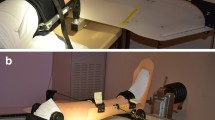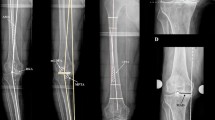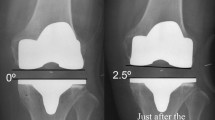Abstract
Purpose
To evaluate preoperative soft tissue balance for total knee arthroplasty (TKA), varus/valgus stress radiographs has been used in previous studies. While the joint line of femur and tibia is almost parallel in healthy and postoperative knees, osteoarthritis (OA) knees exhibit articular cartilage wear that causes the joint line tilting even in a non-stress condition. Therefore, the exact angle of the joint line might mislead to understand the joint laxity in OA knees. The purpose of this study was to evaluate soft tissue balance in varus OA knees using preoperative stress radiographs under three different constant loads, taking the articular cartilage wear into consideration.
Methods
One hundred and eighteen varus-deformed OA knees in 102 patients were investigated before primary TKA. Preoperative knee radiographs were obtained in the anteroposterior view with no stress (defined as the neutral condition) and with varus and valgus stresses (5, 10, and 15 kg) in extension. Two different types of joint line angle (JLA), the absolute JLA (an exact angle of joint line) and the relative JLA (the absolute JLA minus the JLA in the neutral condition), were compared for the same load with the paired t test.
Results
The absolute JLA was 7.9 ± 1.2°/− 1.5 ± 2.2° under varus/valgus 15 kg stress, 6.7 ± 2.4°/− 0.3 ± 2.1° under varus/valgus 10 kg stress, and 4.7 ± 2.4°/1.1 ± 2.2° under varus/valgus 5 kg stress. Significant differences in the numerical values of the absolute JLA were observed between varus and valgus stresses for each load. The neutral JLA was 3.2 ± 2.0°. The relative JLA was 4.8 ± 2.1°/− 4.7 ± 1.8° under varus/valgus 15 kg stress, 3.5 ± 2.0°/− 3.5 ± 1.8° under varus/valgus 10 kg stress, and 1.5 ± 1.9°/− 2.1 ± 1.8° under varus/valgus 5 kg stress. No significant differences in the numerical values of the relative JLA were observed between varus and valgus stresses for each load.
Conclusions
Consideration of cartilage wear allowed knee laxity to be evaluated more precisely in this study than in previous reports. It was shown that medial soft tissue contracture did not always exist, even in varus OA knees. Regarding clinical relevance, surgeons should be aware that underestimating medial soft tissue laxity due to reliance on the absolute JLA might lead to excessive medial tissue release and result in postoperative instability and lower patient satisfaction.
Level of evidence
IV.







Similar content being viewed by others
Abbreviations
- TKA:
-
Total knee arthroplasty
- OA:
-
Osteoarthritis
- JLA:
-
Joint line angle
- AP:
-
Anteroposterior
- FTA:
-
Femorotibial angle
- HKA:
-
Hip–knee–ankle
- MPTA:
-
Medial proximal tibia angle
- PTA:
-
Posterior tibial slope
- OARSI:
-
Osteoarthritis Research Society International
- K–L:
-
Kellgren–Lawrence
- ICC:
-
Intraclass correlation coefficients
References
Altman RD, Gold GE (2007) Atlas of individual radiographic features in osteoarthritis, revised. Osteoarthr Cartil 15:1–56
Bellemans J, Vandenneucker H, Vanlauwe J, Victor J (2010) The influence of coronal plane deformity on mediolateral ligament status: an observational study in varus knees. Knee Surg Sports Traumatol Arthrosc 18:152–156
Harrington IJ (1983) Static and dynamic loading patterns in knee joints with deformities. J Bone Jt Surg Am 65:247–259
Hirschmann MT, Behrend H (2018) Functional knee phenotypes: a call for a more personalised and individualised approach to total knee arthroplasty? Knee Surg Sports Traumatol Arthrosc 0:1–2
Ishii Y, Noguchi H, Matsuda Y, Kiga H, Takeda M, Toyabe SI (2009) Preoperative laxity in osteoarthritis patients undergoing total knee arthroplasty. Int Orthop 33:105–109
Kellgren J, Lawrence J (1957) Radiological Assessment of Osteo-Arthrosis. Ann Rheuma Dis 16:494–502
Kuriyama S, Ishikawa M, Nakamura S, Furu M, Ito H, Matsuda S (2016) No condylar lift-off occurs because of excessive lateral soft tissue laxity in neutrally aligned total knee arthroplasty: a computer simulation study. Knee Surg Sports Traumatol Arthrosc 24:2517–2524
Kuroyanagi Y, Nagura T, Kiriyama Y, Matsumoto H, Otani T, Toyama Y, Suda Y (2012) A quantitative assessment of varus thrust in patients with medial knee osteoarthritis. Knee 19:130–134
Lobenhoffer H, Bosch U, Gerich T (1996) Role of posterior capsulotomy for the treatment of extension deficits of the knee. Knee Surg Sports Traumatol Arthrosc 4:237–241
Matsuda Y, Ishii Y, Noguchi H, Ishii R (2005) Varus-valgus balance and range of movement after total knee arthroplasty. J Bone Jt Surg Br 87:804–808
Matsumoto T, Takayama K, Muratsu H, Matsushita T, Kuroda R, Kurosaka M (2015) Semimembranosus release reduces tibial internal rotation and flexion angle in cruciate-retaining total knee arthroplasty. J Arthroplast 30:1537–1541
Morrison JB (1970) The mechanics of the knee joint in relation to normal walking. J Biomech 3:51–61
Nakamura S, Ito H, Yoshitomi H, Kuriyama S, Komistek RD, Matsuda S (2015) Analysis of the flexion gap on in vivo knee kinematics using fluoroscopy. J Arthroplast 30:1237–1242
Ogawa H, Matsumoto K, Ogawa T, Takeuchi K, Akiyama H (2016) Preoperative varus laxity correlates with overcorrection in medial opening wedge high tibial osteotomy. Arch Orthop Trauma Surg 136:1337–1342
Okamoto S, Okazaki K, Mitsuyasu H, Matsuda S, Iwamoto Y (2013) Lateral soft tissue laxity increases but medial laxity does not contract with varus deformity in total knee arthroplasty knee. Clin Orthop Relat Res 471:1334–1342
Okazaki K, Miura H, Matsuda S, Takeuchi N, Mawatari T, Hashizume M, Iwamoto Y (2006) Asymmetry of mediolateral laxity of the normal knee. J Orthop Sci 11:264–266
Ren D, Liu Y, Zhang X, Song Z, Lu J, Wang P (2017) The evaluation of the role of medial collateral ligament maintaining knee stability by a finite element analysis. J Orthop Surg Res 12:64
Siston RA, Goodman SB, Delp SL, Giori NJ (2007) Coronal plane stability before and after total knee arthroplasty. Clin Orthop Relat Res 463:43–49
Tsukiyama H, Kuriyama S, Kobayashi M, Nakamura S, Furu M, Ito H, Matsuda S (2017) Medial rather than lateral knee instability correlates with inferior patient satisfaction and knee function after total knee arthroplasty. Knee 24:1478–1484
Walter SD, Eliasziw M, Donner A (1998) Sample size and optimal designs for reliability studies. Stat Med 17:101–110
Warren PJ, Olanlokun TK, Cobb AG, Walker PS, Iverson BF (1994) Laxity and function in knee replacements. A comparative study of three prosthetic designs. Clin Orthop Relat Res 305:200–208
Funding
There was no funding for this study.
Author information
Authors and Affiliations
Contributions
TU collected and analyzed the data and drafted the manuscript. HM is the corresponding author, and conceived of the study, participated in its design, collected and analyzed the data, and helped to draft the manuscript. KO collected and analyzed the data and assisted in drafting the manuscript. KM and YM collected and analyzed the data. YA assisted in drafting the manuscript. YN gave final approval to the manuscript.
Corresponding author
Ethics declarations
Conflict of interest
HM: Zimmer Biomet, paid presenter or speaker. KO: Zimmer Biomet, paid presenter or speaker; Smith & Nephew, paid presenter or speaker.
Ethical approval
The study protocol was approved by the Institutional Review Board of Kyushu University (IRB number 28-366).
Informed consent
Informed consent was obtained from all individual participants included in the study.
Rights and permissions
About this article
Cite this article
Ushio, T., Mizu-uchi, H., Okazaki, K. et al. Medial soft tissue contracture does not always exist in varus osteoarthritis knees in total knee arthroplasty. Knee Surg Sports Traumatol Arthrosc 27, 1642–1650 (2019). https://doi.org/10.1007/s00167-018-5276-9
Received:
Accepted:
Published:
Issue Date:
DOI: https://doi.org/10.1007/s00167-018-5276-9




